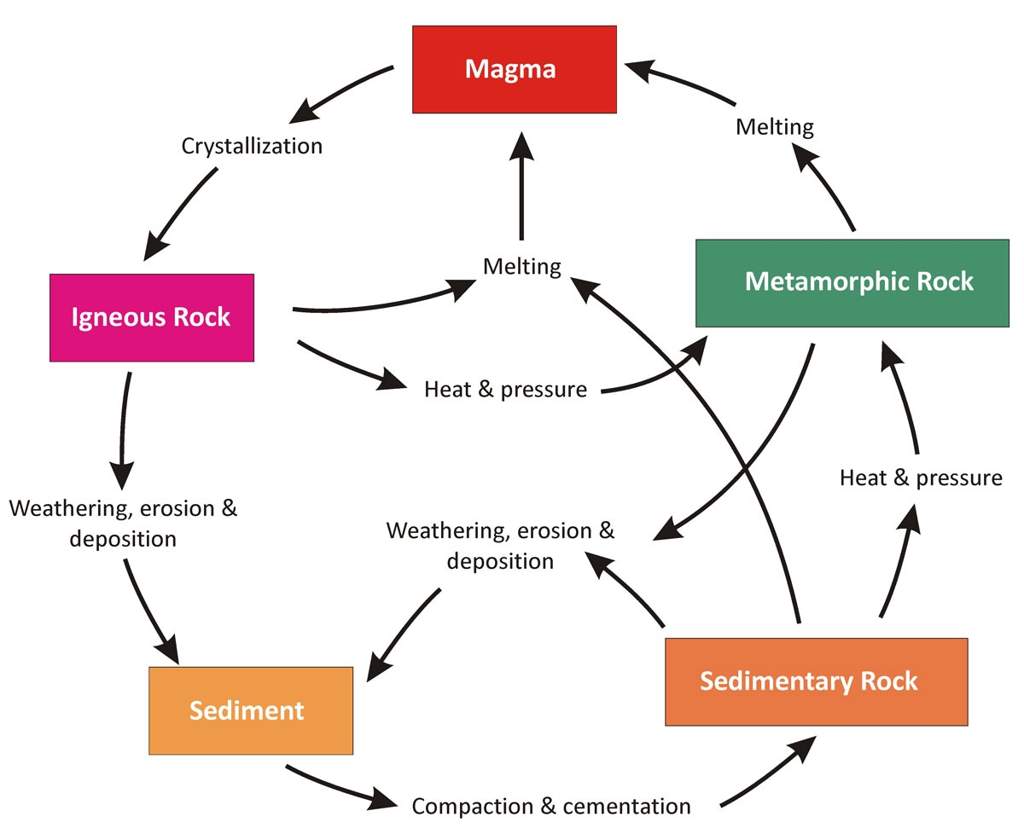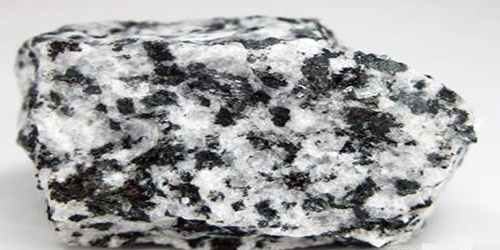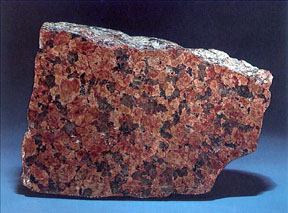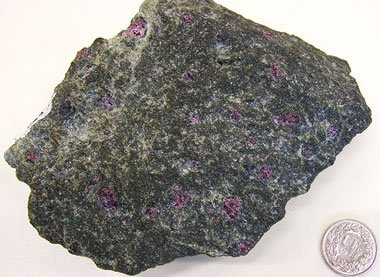What is the rock cycle?
The rock cycle is a concept in geology that describes how rocks change through geologic time.

Intrusive Igneous Rocks
Intrusive, or plutonic, igneous rocks form when magma cools slowly below the Earth's surface. Most intrusive rocks have large, well-formed crystals.

Diorite is an intrusive igneous rock with a composition between that of granite and basalt. It usually occurs as large intrusions (---), dikes (---) and sills (---) within continental crust. These often form above a convergent plate boundary where an oceanic plate sub-ducts underneath a continental plate. Melting of the oceanic plate produces a basaltic magma (---) that rises and intrudes the granitic rock of the continental plate. There, the basaltic magma mixes with granitic magma's or melts granitic rock as it ascends through the continental plate. This produces a melt that is intermediate in composition between basalt and granite. Diorite forms if this type of melt crystallises below the surface.

Gabbro is an intrusive igneous rock, it is usually black or dark green in colour and composed mainly of the minerals plagioclase (---) and augite (---) . Could find out much more.

Granite is a light coloured intrusive igneous rock with grains (---) large enough to be visible with no special equipment. It forms from the slow crystallisation of magma below Earth's surface. Granite is compose mainly of quartz (---) and feldspar (---) with little bits of mica (---), amphiboles (---), and other minerals. This mineral composition usually gives granite a red, pink, grey or white colour with dark mineral grains visible through out the rock.

Pegmatite are intrusive igneous rocks that form during the final stage of magma's crystallisation.
They contain large crystals and they sometimes contain minerals that are rarely found in other types of rocks (---). The name pegmatite has nothing to do with the mineral composition of the rock. Most pegmatite have a composition similar to that of granite.

Peridotite is a dark coloured, ultramafic (---) igneous rock. Peridotite contain olivine (---) as its primary mineral, also with other mafic minerals like pyroxenes and amphiboles. Their silica (---) content is low compared to other igneous rocks. They also contain very little quartz and feldspar. Much of earths mantle is believed to be Peridotite. different types of Peridotite include dunite, lherzolite, harzburgite, wehrlite.

Extrusive Igneous Rocks
Extrusive igneous rocks form when magma reaches the Earth's surface a volcano and cools quickly. Most extrusive (volcanic) rocks have small crystals.

Andesite is an extrusive igneous rock that is usually light to dark grey in colour.
Basalt
Obsidian
Pumice
Rhyolite
Scoria
Clastic Sedimentary Rocks
Breccia
Conglomerate
Sandstone
Siltstone
Shale
Chemical Sedimentary Rocks
Iron ore
Chert
Flint
Dolomites
Limestones
Organic Sedimentary Rocks
Coal
Dolomites
Limestones
The rock cycle is a concept in geology that describes how rocks change through geologic time.

Intrusive Igneous Rocks
Intrusive, or plutonic, igneous rocks form when magma cools slowly below the Earth's surface. Most intrusive rocks have large, well-formed crystals.

Diorite is an intrusive igneous rock with a composition between that of granite and basalt. It usually occurs as large intrusions (---), dikes (---) and sills (---) within continental crust. These often form above a convergent plate boundary where an oceanic plate sub-ducts underneath a continental plate. Melting of the oceanic plate produces a basaltic magma (---) that rises and intrudes the granitic rock of the continental plate. There, the basaltic magma mixes with granitic magma's or melts granitic rock as it ascends through the continental plate. This produces a melt that is intermediate in composition between basalt and granite. Diorite forms if this type of melt crystallises below the surface.

Gabbro is an intrusive igneous rock, it is usually black or dark green in colour and composed mainly of the minerals plagioclase (---) and augite (---) . Could find out much more.

Granite is a light coloured intrusive igneous rock with grains (---) large enough to be visible with no special equipment. It forms from the slow crystallisation of magma below Earth's surface. Granite is compose mainly of quartz (---) and feldspar (---) with little bits of mica (---), amphiboles (---), and other minerals. This mineral composition usually gives granite a red, pink, grey or white colour with dark mineral grains visible through out the rock.

Pegmatite are intrusive igneous rocks that form during the final stage of magma's crystallisation.
They contain large crystals and they sometimes contain minerals that are rarely found in other types of rocks (---). The name pegmatite has nothing to do with the mineral composition of the rock. Most pegmatite have a composition similar to that of granite.

Peridotite is a dark coloured, ultramafic (---) igneous rock. Peridotite contain olivine (---) as its primary mineral, also with other mafic minerals like pyroxenes and amphiboles. Their silica (---) content is low compared to other igneous rocks. They also contain very little quartz and feldspar. Much of earths mantle is believed to be Peridotite. different types of Peridotite include dunite, lherzolite, harzburgite, wehrlite.

Extrusive Igneous Rocks
Extrusive igneous rocks form when magma reaches the Earth's surface a volcano and cools quickly. Most extrusive (volcanic) rocks have small crystals.

Andesite is an extrusive igneous rock that is usually light to dark grey in colour.
Basalt
Obsidian
Pumice
Rhyolite
Scoria
Clastic Sedimentary Rocks
Breccia
Conglomerate
Sandstone
Siltstone
Shale
Chemical Sedimentary Rocks
Iron ore
Chert
Flint
Dolomites
Limestones
Organic Sedimentary Rocks
Coal
Dolomites
Limestones
No comments:
Post a Comment
Note: only a member of this blog may post a comment.